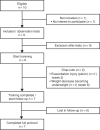HIGH-VOLUME AND HIGH-INTENSITY FUNCTIONAL TRAINING IN PATIENTS WITH MULTIPLE SCLEROSIS: A PILOT STUDY ON FEASIBILITY AND FUNCTIONAL CAPACITY
- PMID: 35528146
- PMCID: PMC9020471
- DOI: 10.2340/jrmcc.v5.2047
HIGH-VOLUME AND HIGH-INTENSITY FUNCTIONAL TRAINING IN PATIENTS WITH MULTIPLE SCLEROSIS: A PILOT STUDY ON FEASIBILITY AND FUNCTIONAL CAPACITY
Abstract
Objective: To evaluate the feasibility of a high-volume and high-intensity functional training programme in patients with multiple sclerosis (MS), and to explore whether functional capacity improves. A further objective was to explore changes in muscle strength and aerobic capacity.
Methods: This pilot study comprised a 12-week intervention, with an 8-week follow-up period. The intervention consisted of 3 weekly 3-h training sessions, comprising functional resistance-, endurance-, and skills training. Feasibility (questionnaire), functional capacity (Timed Up and Go Test, 10-Meter Walk Test, and 6-Minute Walk Test), aerobic capacity (cardiopulmonary exercise test) and muscle strength (1 repetition maximum (RM) leg press) were evaluated.
Results: Seven patients completed the study. Patients attended a mean of 93% of the training sessions. One adverse event was reported, which was not related to the training programme. Patients scored positive or very positive on 86% of the feasibility aspects and scored an overall grade of 8.9 on a scale of 1-10 regarding satisfaction with the training programme. Functional capacity, aerobic capacity, and muscle strength seemed to be improved after the training programme, but the improvements were not always sustained.
Conclusion: This new high-volume and high-intensity functional training programme appeared to be feasible in patients with MS, and may improve their functional capacity, aerobic capacity and muscle strength. A large-scale controlled trial over a longer period of time is required to evaluate the added value of the training programme.
Keywords: exercise therapy; multiple sclerosis; rehabilitation.
© Published by Medical Journals Sweden, on behalf of the Foundation for Rehabilitation Information.
Conflict of interest statement
The authors have no conflicts of interest to declare.
Figures



Similar articles
-
Erratum.Mult Scler. 2016 Oct;22(12):NP9-NP11. doi: 10.1177/1352458515585718. Epub 2015 Jun 3. Mult Scler. 2016. PMID: 26041800
-
Feasibility and efficacy of home-based neurofunctional exercise vs. resistance exercise programs for ambulatory disability of multiple sclerosis patients with cognitive impairment.Mult Scler Relat Disord. 2022 Feb;58:103400. doi: 10.1016/j.msard.2021.103400. Epub 2021 Nov 13. Mult Scler Relat Disord. 2022. PMID: 35216783 Clinical Trial.
-
Community-based group aquatic programme for individuals with multiple sclerosis: a pilot study.Disabil Rehabil. 2011;33(9):720-8. doi: 10.3109/09638288.2010.507855. Epub 2010 Aug 20. Disabil Rehabil. 2011. PMID: 20726740
-
Association Between Physical Exercise Interventions Participation and Functional Capacity in Individuals with Type 2 Diabetes: A Systematic Review and Meta-Analysis of Controlled Trials.Sports Med Open. 2022 Mar 4;8(1):34. doi: 10.1186/s40798-022-00422-1. Sports Med Open. 2022. PMID: 35244804 Free PMC article.
-
Exercise training undertaken by people within 12 months of lung resection for non-small cell lung cancer.Cochrane Database Syst Rev. 2019 Jun 17;6(6):CD009955. doi: 10.1002/14651858.CD009955.pub3. Cochrane Database Syst Rev. 2019. PMID: 31204439 Free PMC article.
Cited by
-
Walking performance differs between people with multiple sclerosis who perform distinct types of exercise.Neurodegener Dis Manag. 2024;14(3-4):75-85. doi: 10.1080/17582024.2024.2389037. Epub 2024 Aug 19. Neurodegener Dis Manag. 2024. PMID: 39155765 Free PMC article.
-
High-Intensity Functional Training: Perceived Functional and Psychosocial Health-Related Outcomes from Current Participants with Mobility-Related Disabilities.Sports (Basel). 2023 Jun 12;11(6):116. doi: 10.3390/sports11060116. Sports (Basel). 2023. PMID: 37368566 Free PMC article.
References
-
- Langeskov-Christensen M, Heine M, Kwakkel G, Dalgas U. Aerobic capacity in persons with multiple sclerosis: a systematic review and meta-analysis. Sports Med 2015; 45: 905–923. - PubMed
-
- Motl RW. Physical activity and irreversible disability in multiple sclerosis. Exerc Sport Sci Rev 2010; 38: 186–191. - PubMed
LinkOut - more resources
Full Text Sources

